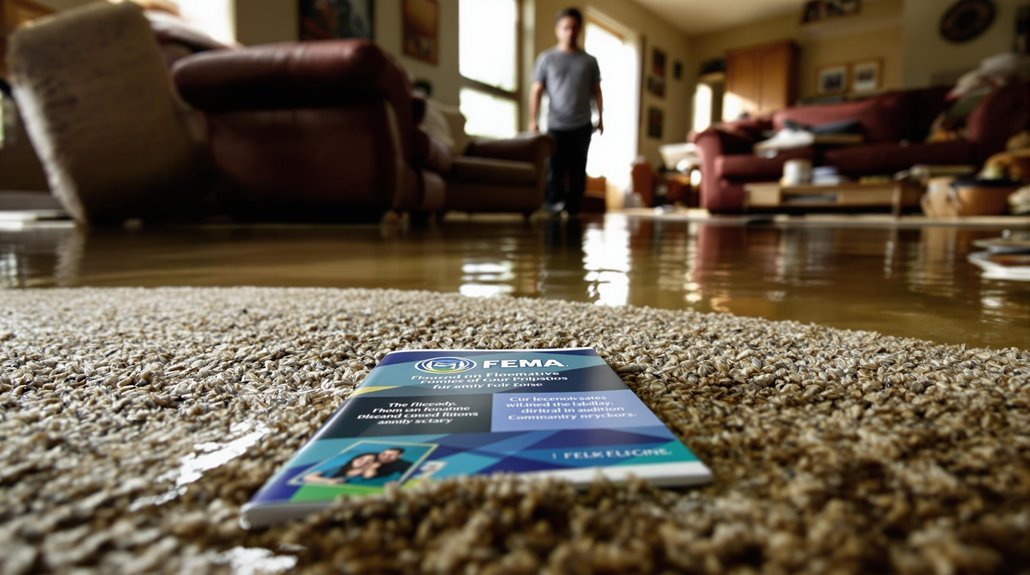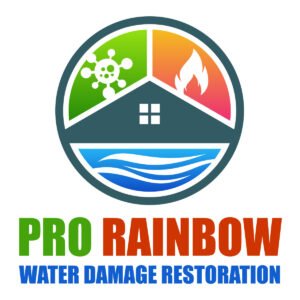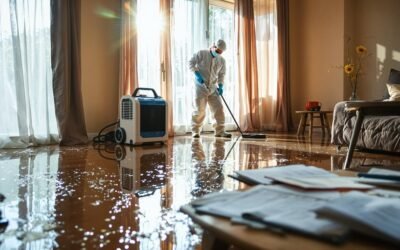FEMA can help cover certain water damage, but it's essential to know what qualifies. Assistance is typically available for damage resulting from federally declared disasters, like flooding. Nevertheless, not all types of water damage are covered, such as issues from sewer backups or normal wear and tear. To qualify, you must reside in a designated disaster area and provide thorough documentation of your losses. Understanding these criteria can streamline your application process and improve your chances of aid. If you're looking for more details on eligibility and types of assistance, there's valuable information waiting for you.
Key Takeaways
- FEMA covers certain water damage from federally declared disasters, primarily flood damage and structural losses to homes.
- Assistance eligibility requires applicants to be U.S. citizens or qualified non-citizens in designated disaster areas with documented damage.
- Non-covered damages include sewer backups, maintenance neglect, and temporary housing expenses, which FEMA does not reimburse.
- Applicants must provide thorough documentation, including identification, proof of ownership, and evidence of damage, to qualify for assistance.
- Various assistance types are available, including rental assistance, housing repairs, and personal property aid for documented losses.
Understanding FEMA's Role

When disaster strikes, understanding FEMA's role becomes fundamental for those affected by water damage. FEMA, or the Federal Emergency Management Agency, provides significant assistance during the disaster recovery process. If you've experienced significant water damage, you may qualify for various forms of FEMA assistance. This can include financial aid for temporary housing, home repairs, and other important needs. It's vital to document your damage thoroughly and apply for assistance as soon as possible to expedite your recovery. Furthermore, FEMA can guide you through the process, helping you understand the resources available. By recognizing FEMA's role, you can navigate the complexities of recovery more effectively, ensuring you receive the support necessary to rebuild your life after a disaster. Additionally, it's important to consider emergency water removal services to minimize damage rapidly during the initial response phase.
Types of Water Damage
Water damage can manifest in several ways, each with distinct causes and consequences. Understanding these types can help you address issues effectively. Here are four common types of water damage:
- Flood Damage: Often caused by natural disasters, floods can severely impact your property, leading to extensive repairs.
- Plumbing Issues: Burst pipes or faulty fixtures can result in significant water accumulation, damaging walls and flooring.
- Roof Leaks: Water can seep through damaged roofs, leading to mold and structural problems.
- Sewer Backup: This dangerous situation poses health risks and requires immediate attention to prevent further damage.
Recognizing these types of water damage allows you to take proactive steps and seek appropriate assistance when needed. Additionally, emergency water removal services are crucial in minimizing damage and preventing mold growth after an incident.
FEMA Eligibility Criteria
Understanding FEMA eligibility criteria is crucial for anyone affected by water damage, as it determines access to important assistance. To qualify for FEMA assistance, you must meet specific requirements outlined in the FEMA assistance guidelines. Typically, you need to be a U.S. citizen or a qualified non-citizen, and your home must be located in a designated disaster area. Furthermore, your water damage must be a direct result of a federally declared disaster. It's important to document the damage and any related expenses thoroughly. By ensuring you meet these disaster funding eligibility criteria, you can improve your chances of receiving the help you need to recover and rebuild after a water-related disaster.
Covered vs. Non-Covered Damages
While guiding through the aftermath of water damage, it's vital to know what FEMA will cover and what it won't. Understanding this distinction can greatly impact your recovery efforts. Here's a quick overview:
- Covered Damages: Structural damage from flooding, critical utilities, and personal property losses.
- Non-Covered Damages: Damage from sewer backups, maintenance neglect, and flood insurance exclusions.
- Additional Non-Covered: Temporary housing expenses and damage to vehicles.
- Other Considerations: Losses from natural wear and tear aren't typically covered.
Recognizing these covered and non-covered damages helps you navigate FEMA's assistance effectively. Knowing what's eligible can guide your recovery strategy and financial planning, ensuring you focus on what truly matters in your restoration journey.
The Application Process
Maneuvering through the FEMA application process can feel overwhelming, but understanding the eligibility requirements is your first step. You'll need to gather specific documentation to support your claim, ensuring you have everything in order before submission. Let's break down the necessary steps to make this process smoother for you.
Eligibility Requirements Explained
When you're dealing with water damage, knowing the eligibility requirements for FEMA assistance can make a significant difference in your recovery process. To qualify, you'll need to take into account:
- Your home must be in a designated disaster area.
- You must demonstrate that the damage is a result of a declared disaster event.
- Insurance coverage must be inadequate to cover the water damage.
- You should apply within the specified timeframe after the disaster.
Understanding these criteria is vital, especially if you've taken steps for water damage prevention or have existing insurance coverage. By familiarizing yourself with these requirements, you can navigate the application process more effectively and secure the assistance you need to rebuild and recover.
#
Required Documentation
Checklist
Gathering the right documentation is vital for a smooth FEMA application process following water damage. To guarantee claim verification, start by collecting your identification documents, such as a driver's license or passport. Next, gather proof of ownership or occupancy, like a mortgage statement or lease agreement. You'll furthermore need photos or videos showing the damage, which can serve as critical documentation necessities. Moreover, prepare estimates for repairs and any relevant insurance information. It's important to keep all records organized and accessible. This thorough documentation will not only support your claim but also streamline the review process, helping you receive the assistance you need more quickly. Taking these steps can greatly ease the stress during a challenging time.
Application Submission Steps
To guarantee your application is processed efficiently, you'll want to follow a series of steps that guide you through the submission process. Here are some application tips to keep in mind:
- Gather Required Information: Collect all necessary documents, including identification and proof of damage.
- Complete the Application: Fill out the FEMA application accurately, making sure all sections are addressed.
- Submit on Time: Be aware of the submission timeline—delays can affect your eligibility.
- Follow Up: After submission, check your application status to verify it's being processed.
## Required Documentation
How can you guarantee your claim to FEMA is processed smoothly after experiencing water damage? Understanding the documentation requirements is vital. You'll need to gather key papers, including proof of ownership, photographs of the damage, and receipts for repairs or replacement items. In addition, any insurance information should be included to clarify what's already covered. These documents will support your claim submission, helping FEMA assess your situation more effectively. Be meticulous in organizing your paperwork and make sure everything is legible. The clearer your documentation, the faster your claim can move through the system. Remember, thorough preparation not only reinforces your case but also alleviates the emotional burden during a challenging time.
Assistance for Renters

If you're a renter affected by water damage, understanding the eligibility criteria for FEMA assistance can be essential. There are various types of aid available, designed to help you recover and secure stable housing. Knowing your options can empower you to navigate the recovery process effectively.
Eligibility Criteria for Renters
While maneuvering through the aftermath of water damage, understanding the eligibility criteria for renter assistance can greatly ease your burden. Here are key points to take into account:
- You must be a tenant, not a homeowner.
- Your rental property should be located in a declared disaster area.
- You should demonstrate financial need, as FEMA aid is typically based on your income.
- Renters insurance may affect your eligibility, so it's vital to know your policy details.
Understanding your tenant rights is just as significant, as it empowers you to claim any assistance you may be entitled to. Steering through these criteria can feel overwhelming, but knowing what you qualify for guarantees you receive the support you need during this challenging time.
Types of Assistance Available
Steering through the types of assistance available for renters after water damage can greatly impact your recovery process. Understanding your options is essential, especially when it comes to water damage prevention and insurance coverage. FEMA offers various programs tailored to support renters in distress.
| Assistance Type | Description | Eligibility Criteria |
|---|---|---|
| Rental Assistance | Financial aid for temporary housing | Must meet income limits |
| Direct Housing Assistance | FEMA-provided housing solutions | Must be in declared disaster area |
| Personal Property Assistance | Help with replacing damaged items | Documented losses required |
Other Disaster Assistance Programs
Although FEMA plays a crucial role in disaster recovery, various other assistance programs can provide significant support during times of crisis. Here are some options you might consider:
- State and Local Programs: Many states offer financial aid for disaster recovery tailored to specific needs.
- Nonprofit Organizations: Groups like the Red Cross often provide immediate assistance and resources.
- Housing Assistance: Programs aimed at helping you find temporary or permanent housing after a disaster.
- Small Business Administration (SBA): The SBA offers low-interest loans for businesses affected by disasters, helping them recover financially.
Tips for Filing a Claim

Filing a claim with FEMA can be a challenging process, but understanding a few key tips can streamline your experience and increase your chances of success. First, focus on thorough claim preparation. Gather all necessary documents, including photos of damage and receipts for repairs. Here are some vital documentation tips:
| Document Type | Purpose | Importance |
|---|---|---|
| Photos of Damage | Visual evidence of loss | Strengthens claim |
| Repair Receipts | Proof of expenses incurred | Validates costs |
| Insurance Policies | Clarifies coverage | Avoids confusion |
| FEMA Forms | Official application | Required for filing |
Conclusion
Steering through water damage can feel like weathering a storm, but understanding FEMA's assistance options can illuminate your path to recovery. By knowing what's covered and the eligibility criteria, you're not just a victim; you're a survivor reclaiming your space. Whether you're a homeowner or a renter, remember that help is within reach. With the right documentation and a clear application, you can turn this tumultuous chapter into a story of resilience and hope.




